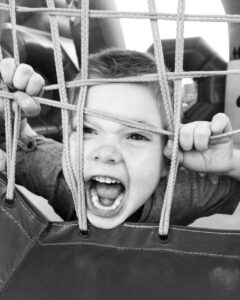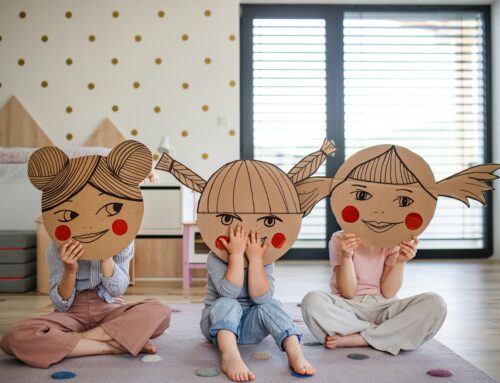When your children are so filled with emotions, do they dissolve into tears, start yelling, run to their room, or begin to panic? Big emotions can feel scary and overwhelming – for kids and their parents. But there are some simple steps to help kids express their emotions in healthy ways.
The biology of big emotions.
 First, let’s talk briefly about what happens in our bodies when we feel these big emotions. When a big emotion comes, typically it floods the front of the brain, called the prefrontal cortex, which effectively shuts down the part of our brain that makes good decisions. Carlsbad Christian Counseling is here to support you in that journey.
First, let’s talk briefly about what happens in our bodies when we feel these big emotions. When a big emotion comes, typically it floods the front of the brain, called the prefrontal cortex, which effectively shuts down the part of our brain that makes good decisions. Carlsbad Christian Counseling is here to support you in that journey.
Our prefrontal cortex goes offline letting our amygdala (our natural instinct) be in charge. God designed our brains like this so that if we’re in danger – like being chased by a bear – our instincts will give a “fight, flight or freeze,” response i.e. fight the bear, run away from the bear, or freeze so the bear doesn’t notice us.
When our body jumps into action because we think we’re in danger, adrenaline starts racing through our body, causing the heart to beat fast. Notice what happens in your own body when you start feeling a big emotion.
Does your heart start racing? Do you feel nauseous? Is your stomach in knots? What about your muscles? Do you clench your jaw or curl your hands into fists? Do your shoulders get so tight that they almost reach your ears? For parents, noticing their child’s “tell” can help them intervene before the child becomes overwhelmed with emotion.
Deep breathing helps regulate the mind and body.
Deep breathing is one of the best ways to help our bodies realize we’re not in danger, reducing the adrenaline flowing through our bodies and bringing the prefrontal cortex back online. There are lots of techniques for deep breathing.
Here’s one option: Take a slow breath in, hold it, let it fill your whole body, and then breathe out with your mouth. For children, when they’re emotionally dysregulated, if they let you hold them or hug them, then you can co-regulate with them, taking deep breaths together. (See below for tips on teaching children deep breathing.)
 When the child has taken a few deep breaths and their body is becoming more relaxed and regulated, then you can help them name their feeling, like “I’m so frustrated that …” (Tips on teaching the language of emotion are below.)
When the child has taken a few deep breaths and their body is becoming more relaxed and regulated, then you can help them name their feeling, like “I’m so frustrated that …” (Tips on teaching the language of emotion are below.)
The important thing is to validate the emotion. Don’t dismiss it, no matter how much you think it’s irrational. Say something like, “I hear you’re frustrated because …” Or you might have to help them name their emotion with something like “Are you feeling sad or frustrated?”
This can help our kids resist acting out in physical or aggressive ways, such as hitting or throwing something. Instead, they learn to regulate their bodies through deep breathing and identifying and processing their emotions.
Deep breathing tips.
The best time to teach deep breathing is when your child is feeling relaxed and calm. Explain that deep breathing helps bring our wise mind back “online.” There are a variety of deep breathing techniques that are effective in helping regulate our bodies and minds. Here’s one way to help kids practice deep breathing:
- Have them hold up their pointer finger in front of their face and pretend to smell a flower by breathing in with their nose slowly.
- Then the finger becomes the end of a balloon, and they are filling up the entire balloon with air – their whole body from their toes to their fingers to the top of their head.
- Then the finger becomes a birthday candle, and they slowly breathe out with their mouth, like they’re blowing out a birthday candle.
- Do that several times, and practice it regularly, so it’s second nature when they’re feeling big emotions.
Identifying their feelings.
Helping your children learn to identify their emotions is an important step in reducing those big, overwhelming outbursts. Giving them the language of emotions helps them learn to communicate what they’re feeling using words instead of screaming, throwing things, or becoming physically aggressive.
 By having the language of emotion as part of your family conversation, your kids will be able to name what they’re feeling. So when those big feelings come, they can more accurately say, “I’m frustrated” or “I’m angry” instead of demonstrating their emotions by acting out physically.
By having the language of emotion as part of your family conversation, your kids will be able to name what they’re feeling. So when those big feelings come, they can more accurately say, “I’m frustrated” or “I’m angry” instead of demonstrating their emotions by acting out physically.
When your child needs help regulating their emotions, you can help them take deep breaths and then label their emotion(s). For example, if they come running to you in tears because someone took their turn on the slide at the playground, you can give them a big hug, take a few deep breaths with them, and then help them label that emotion. “Are you feeling frustrated? Or sad? Or angry?”
To which they might say – between sobs – “I’m very angry! And really sad!” Being able to identify that emotion is the first step toward helping them become more regulated. Then encourage them to take some slow deep breaths with you until their body begins to relax, their heart rate slows down, and they’re crying softens or stops.
Adults often try to talk kids out of their emotions, which can feel scarier and more overwhelming. Instead, validate their emotion and accept the label they’ve given it. Refrain from saying such colloquialisms as “Don’t cry” or “Don’t be said.” Instead, you can say things like, “I’ve got you,” “You’re safe,” “I’m here.”
Fun with feelings tips.
Here are some fun ideas to help you and your family begin to use the language of emotion:
Role-play with toys.
Gather stuffed animals, dolls, or puppets to identify and act out different emotions. For example, you might have the bear act like it’s crying and say, “I’m so sad,” and create an age-appropriate situation for the bear to be sad, such as he’s out of honey or his friend had to go home for dinner.
Feeling chart.
Use a kid-friendly feeling chart and each night at dinner ask your family to share their top two or three feelings for the day and why they felt that way. After each person shares, be sure to validate the emotion, such as “That does sound frustrating” or “I see why you were angry.”
 You can also set the rule that after every share, you say, “I hear that you were angry” to practice reflecting. Just be careful not to dismiss the emotion or try to fix the situation at that time so you can create a safe space for their expression. (Kid-friendly feeling charts are available online or can be purchased on Amazon.)
You can also set the rule that after every share, you say, “I hear that you were angry” to practice reflecting. Just be careful not to dismiss the emotion or try to fix the situation at that time so you can create a safe space for their expression. (Kid-friendly feeling charts are available online or can be purchased on Amazon.)
Charades.
Play a feelings charade and have the kids act out various emotions while others guess. Then discuss times they might have felt that way.
Playdough.
Using play dough, encourage your kids to create faces that illustrate the different emotions.
Create feelings masks.
Grab some plain paper plates and have them create a mask of what emotion they usually show when they’re at school or with other kids. Then on the backside, have them draw how they’re feeling in that situation.
That will open the discussion about authenticity and what happens when we don’t feel safe to share our real emotions. You can also add in a conversation about wanting home to be a “safe space” to talk about their emotions.
Freeze dance.
Play freeze dance, where you dance until the music stops, but right before the music comes back on announce a new emotion. Then everyone dances as that emotion, such as sad, excited, angry, anxious, frustrated, etc. Each person can take turns naming an emotion for everyone to dance as.
Catch.
For younger kids who are just learning the language of emotion, you can sit or stand in a circle and roll a ball to each other. Whoever gets the ball, names an emotion and makes a face that demonstrates that emotion. Then everyone says the emotion and makes the same facial expression. This can be done with a balloon or beanbag, as well.
For more information and demonstrations on how to regulate one’s big feelings, visit @cyndieclaypooldeneve on Instagram or Facebook.
If you or your kids need help regulating your emotions and live in California, sign up for a counseling appointment with Cyndie de Neve, LMFT, online or in person in Carlsbad by clicking here or calling (760) 307-4605.
“Lemme Outta Here!”, Courtesy of ruslana_art, Pixabay.com, CC0 License; “Funny Face”, Courtesy of allenlee, Pixabay.com, CC0 License; “Crying”, Courtesy of Anna Shvets, Pexels.com, CC0 License; “Crying on Mommy’s Shoulder”, Courtesy of Bijou Baby, Pexels.com, CC0 License
-
Cyndie Claypool De Neve: Author
As a Christian Licensed Marriage and Family Therapist (LMFT) in California, I love being used by God to bring healing and hope to those who are hurting. I enjoy working with school-aged children, teens, college students, families, couples, and adult...
Recent Posts
-
Kate Motaung: Curator
Kate Motaung is the Senior Writer, Editor, and Content Manager for a multi-state company. She is the author of several books including Letters to Grief, 101 Prayers for Comfort in Difficult Times, and A Place to Land: A Story of Longing and Belonging...
DISCLAIMER: THIS ARTICLE DOES NOT PROVIDE MEDICAL ADVICE
Articles are intended for informational purposes only and do not constitute medical advice; the content is not intended to be a substitute for professional medical advice, diagnosis, or treatment. All opinions expressed by authors and quoted sources are their own and do not necessarily reflect the opinions of the editors, publishers or editorial boards of Stone Oak Christian Counseling. This website does not recommend or endorse any specific tests, physicians, products, procedures, opinions, or other information that may be mentioned on the Site. Reliance on any information provided by this website is solely at your own risk.









